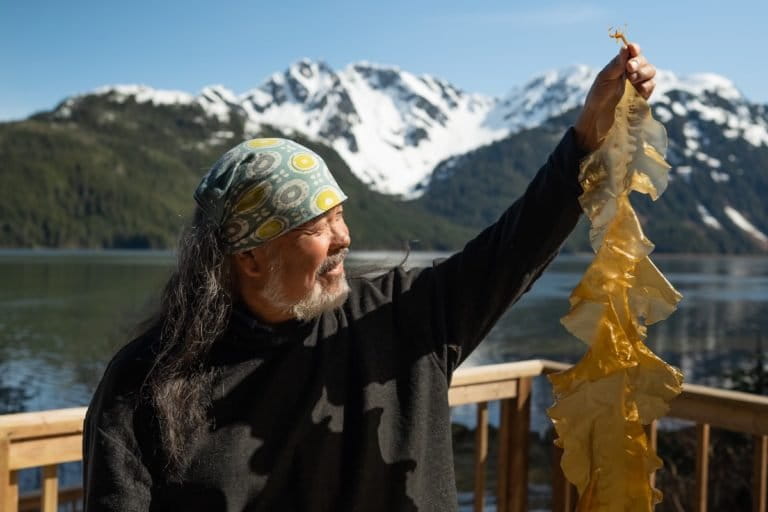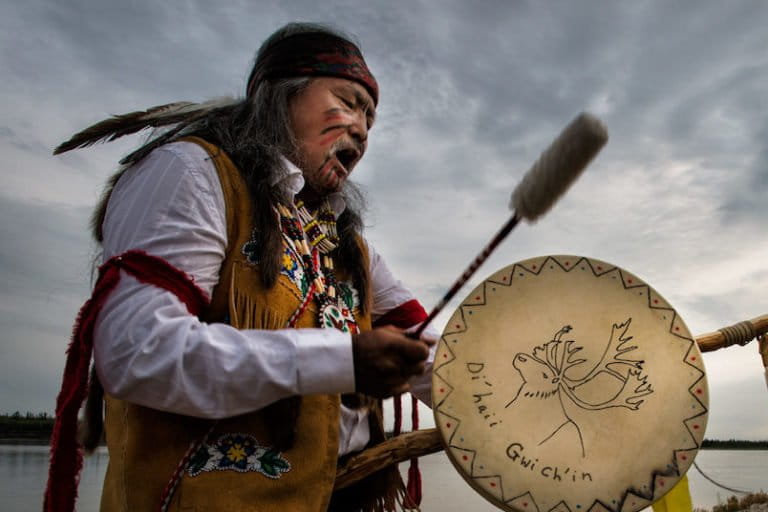- Today, people across the U.S. are observing Indigenous Peoples’ Day, juxtaposed against Columbus Day which is celebrated at the same time, to honor Indigenous peoples and their cultures.
- From conserving some of the last old-growth redwood forests in California to halting oil drilling in the Alaska’s arctic, Indigenous tribes see their participation and knowledge as key to bringing solutions to the biodiversity and climate crises.
- To mark Indigenous Peoples’ Day, Mongabay rounds up five of this year’s most inspiring solutions-based stories in the U.S.
The second Monday of October marks Indigenous Peoples’ Day in multiple cities and states across the U.S. Originally juxtaposed against Columbus Day, celebrated at the same time, the day is set aside to honor Indigenous peoples and their cultures within the country and ecosystems their ancestors have stewarded for millennia.
So far this year, Native American tribes have been involved in multiple conservation and climate mitigation efforts as the U.N. biodiversity conference, COP15, and the climate conference, COP27, loom over the horizon. Both conferences are set to make decisions with wide-ranging impacts on people and societies around the world. Key on the agenda of many communities is ensuring Indigenous participation in environmental and climate efforts and providing solutions embedded in their traditional ecological knowledge.
“Stewardship of the Earth is a big part of our culture,” says John Settlemyre, a conservation outreach coordinator and Muscogee Nation citizen in modern-day Oklahoma. “So [the U.N. biodiversity conference’s goal] aligns with my tribe’s values.”
From conserving some of the last old-growth redwood forests in California to halting oil drilling in Alaska’s arctic, Mongabay rounds up five of this year’s most inspiring stories to mark Indigenous Peoples’ Day.
By cultivating seaweed, Indigenous communities restore connection to the ocean

In Hawai‘i, a community group called Limu Hui seeks to both restore the health of Hawai‘i’s red algae species (known as limu kohu), and pass on the ancestral knowledge of limu held by elders to the next generation.
Limu Hui’s work reflects a much broader trend: many Indigenous communities are working to restore degraded seaweed species that support traditional diets. (Many of these projects work with algae, including limu and kelp, though some touch on seagrasses, a marine plant.) In doing so, these communities are restoring both ecosystems and these species’ traditional cultural functions, a practice known as biocultural restoration.
These projects take many forms, including education, ecosystem restoration, commercial farming, research, or a combination thereof. The group is breaking new ground as it tests methods of transplanting limu species grown in tanks to the wild ocean. Yet the group’s members emphasized that Limu Hui’s true focus is encouraging relationships with limu itself.
“The idea of limu restoration is not so much just limu planting; it’s a pathway for community cohesion,” says Wally Ito, a co-founder of Limu Hui. “To get younger kids out of the house, and get them to touch the limu. Smell the limu. Taste the limu. We have this taste, this ‘ono, of limu. But we cannot pass on that taste to the next generation. They gotta taste it for themselves.”
California redwood forest returned to Indigenous guardianship, conservation

Ten Native American tribal nations, forming the InterTribal Sinkyone Wilderness Council, have received ownership of 215 hectares (532 acres) of California’s redwood forest. The tribal council is partnering with Save the Redwoods League, which donated the land, to protect and restore their traditional coastal forest. Together they have developed a 30-year conservation plan to protect endangered species such as the northern spotted owl (Strix Occidentalis Caurina) and marbled murrelet (Brachyramphus mamoratus).
The conifer forest located on the north coast of the state in Mendocino County, is home to endangered old-growth redwood trees (Sequoia sempervirens), the tallest trees in the world.
In a statement, Save the Redwoods League said that they will be working with the tribal council to apply “a blend of Indigenous place-based land guardianship principles, conservation science, climate adaptation and fire resiliency concepts and approaches to help ensure lasting protection and long-term healing for Tc’ih-Léh-Dûñ and its diverse flora and fauna.”
The transfer of the forest’s ownership, was funded by the Pacific Gas & Electric Company’s (PG&E) Compensatory Mitigation Program. According to the League, PG&E is mitigating potential habitat loss that may result from its operations and maintenance activities throughout the utility’s northern and central California service area.
The forest has been named Tc’ih-Léh-Dûñ in the Sinkyone language as a testimony to the Sinkyone Indigenous peoples who inhabited the region before they were forcibly removed by European and American settlers.
Read more: Mongabay’s story for the International Day of the World’s Indigenous Peoples
Second oil company exits Arctic amid fierce Indigenous opposition, energy squeeze

For decades now, the Gwich’in Steering Committee in Alaska has taken the protection of the Arctic’s Coastal Plain into their own hands and mounted a fierce opposition against oil drilling in the region – resulting in the exit of the second oil company last month.
The company is Knik Arm Services’ (KAS), which had a 19,669-hectare (48,603-acre) lease in the Coastal Plain of the Arctic National Wildlife Refuge (ANWR).
“These exits clearly demonstrate that companies recognize what we have known all along: drilling in the Arctic Refuge is not worth the economic risk and liability that results from development on sacred lands without the consent of Indigenous peoples,” said the Gwich’in Steering Committee in a press statement.
The Gwich’in people learned that the Coastal Plain of the ANWR would be at risk from oil development during the second year of the Trump administration. They then doubled down on their efforts to encourage banks and insurance companies to align with Indigenous rights and speak out against oil and gas development on the reserve.
According to the committee, 29 global banks have implemented a policy to decline underwriting oil and gas projects on the refuge and 14 international insurance companies have said they will not insure development projects in ANWR.
‘The return of land to Indigenous people is key’: Q&A with Shinnecock Kelp Farm’s Tela Troge

The Shinnecock Kelp Farm is the first Indigenous-owned seaweed farm on the East Coast. Its founders hope that it may alter the course of a bay devastated by pollution — and, perhaps, restore the sovereignty of the tribe that cultivated these waters for millennia.
Tela Troge is one of the six women running the farm. Troge is also a member of the Shinnecock Nation, the tribe that has lived on the bay since the end of the last Ice Age.
“We’re taught to think ahead for the next seven generations,” she tells Mongabay. “It’s really a lot of what drives us in educating and sharing our message, and hopefully getting others engaged in taking action to protect the water now.”
Soon after its founding, the Shinnecock Kelp Farm formed a collaboration with the Sisters of St. Joseph, a Catholic organization that focuses on environmental justice. The nuns donated space in their retreat center that sits directly on the edge of Shinnecock Bay. There, the newly minted farmers nurtured sugar kelp (Saccharina latissima) from microscopic cells to young plants ready to transport into their farm.
The team hopes that the harvested kelp — and, in the future, farmed shellfish — can absorb some of the excess nitrogen in Shinnecock Bay, reversing decades of pollution. But Troge says her team can’t fix this problem alone.
Indigenous oyster fisheries were ‘fundamentally different’: Q&A with researcher Marco Hatch

A new study published in Nature Communications studied 28 oyster fisheries along the coasts of North America and Australia and found that Indigenous communities in the region sustainably managed oyster fisheries for more than 5,000 years.
The researchers put together historical sea level data and derived oyster catch records using evidence from archaeological records of oyster middens (heaps of oyster shells). They found oyster fisheries thrived better in these regions than under the European settlers’ management of commercial oyster fisheries. With millions, and sometimes billions of shells harvested, some middens were as tall as 30 feet (about 9 meters), and served as important ceremonial, sacred and symbolic spaces.
Despite the bounty, large-scale depletion or declines of oysters were rare and localized due to traditional knowledge of harvest practices, consumption patterns and farming technologies.
The knowledge of these traditional practices can guide sustainable fisheries management today, say the authors.
“What’s really powerful [about studying Indigenous practices] is that these coastal ecologies, [which have been] sleeping or dormant, are being reawakened,” says Dr. Marco Hatch, a marine ecologist involved in the study and a member of the Samish Indian Nation.
“A community I’m working with now [is] creating the first clam garden in the modern era. Clam gardens are vibrant ecosystems because people have modified them, tended them and harvested them. All of that has created positive feedback where the environment is in fact more abundant—there are more clams and they grow faster.”
Banner image: Elizabeth Azzuz and Margo Robbins, leaders of the Cultural Fire Management Council, have been helping Yurok Tribal members burn their land to improve the growth of basket materials and other traditional plants, see that article here. Photo by Jane Braxton Little for Mongabay
Related listening from Mongabay’s podcast: We look at two Indigenous conservation initiatives in the United States, listen here:
Fire and agroforestry revive California indigenous groups’ traditions
FEEDBACK: Use this form to send a message to the author of this post. If you want to post a public comment, you can do that at the bottom of the page.
